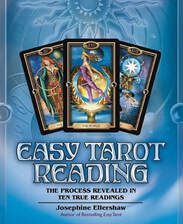You are the magic:
Top Tips for Learning Tarot (Part 1)

Just one of the many interesting things about Tarot is that the same cards can mean different things to different people. If you raise one card with lots of other Tarot readers you can receive varying responses concerning its interpretation.
One of the challenges I often hear from beginners is when they’ve practised on a well-intentioned friend who had some knowledge about Tarot. As the reading progressed the friend continually corrected and questioned their interpretation on various cards. No doubt they were only trying to be helpful but, more often than not, the fledgling reader had their confidence knocked and then they doubted their ability. This is such a shame; as for many beginners gaining confidence to read for others feels quite a big step. Thankfully, most people connected to Tarot are more open and encouraging because they understand. If this has happened to you, or it does in the future, here are some thoughts and a few tips that may help. Different Traditions
Aside from the considerations of three different schools or traditions of the Tarot de Marseilles (TdM), Rider-Waite-Smith (RWS), and Thoth, many modern decks have assigned definitions to the designs of the creators that can vary slightly too. This can often lead to lengthy discussions about the “true” meanings of the cards. Whilst there are some familiar images that are universally acknowledged and fairly constant, there are many others that vary. Rachel Pollack provides excellent comparisons from some of the various traditions in her book, Tarot Wisdom (Llewellyn, 2008) and includes how some of the definitions evolved or differed from 1750 to 1910. I originally started with playing cards, moved over to TdM (when I was old enough to own a Tarot deck), and onto the Rider and Thoth much later. I find that I can’t reconcile some of the definitions on certain cards between the three and whilst some people can happily switch from one deck tradition to another in readings, it’s not something that works well for me. As an example, the meaning of the Seven of Swords from my original TdM stated: new plans, wishes to be fulfilled, and hope. With Thoth the title is: Lord of Unstable Effort, partial success, whereas the RWS speaks of stealth and possible theft. With time my interpretation of this card has changed slightly, to represent handling a situation or person very carefully (the kid-gloves approach). The meaning developed due to various reading situations and experiences but once adopted I felt it worked much better. If I were using the traditional Rider deck then that meaning wouldn’t sit well for me with that particular image, but it suits the Gilded Tarot. Different Strokes for Different Folks As well as the card meanings people also have different styles of reading; some may be predictive in nature, whilst others may work in a more reflective or therapeutic way. Most readers use different spreads, positional or non-positional, and/or design their own, and often a combination, depending upon the circumstances. As most readers develop their experience with the cards they begin to expand their interpretations. Over a period of time we start to see patterns emerging, combinations, or a situation that arises in our own lives that we feel strongly resonates with a particular card that turned up in our reading. For many readers, the card interpretations gradually adapt and grow based on real experiences. Just like the alchemist, it’s a process of subtle blending and refining over time and it constantly evolves. There is no “one” particular way to read the cards so it’s important to stay open-minded to various approaches, but when you’re just getting started try not to combine lots of different methods all at the same time. Find something that feels right for you, learn it well and then add, alter, or adapt it. Experiment by adding changes gradually, so you can find what feels right for you and what provides the best results in your readings. Focus your Intention
When you start learning your cards try not to have too many different (or opposing) interpretations attached to each one because it can become confusing to decide which applies, or your readings may start to sound ambiguous. Focus and project your intention of meaning onto the card, so that when it appears that (core meaning) is what it means to you. There may be some cards that just “don’t sit right,” when you see them, particularly if moving from the image of one deck to another. Most people search, or swap notes and opinions, until they find something that gels, or experiences from their readings point them in a particular direction. Suddenly it’s as though you’ve found a missing piece of the jigsaw and your readings feel better as a result. For those who’ve read Easy Tarot Reading then you’ll know that I use a predictive style of reading, but in order for the readings to be accurate I’ve already set my intention as to what each card means when it appears. Although these may be modified by surrounding cards the core meaning remains. So when particular cards appear in a reading there’s more certainty as to what it means to me. (If you're a “just read what you see” type of reader then this approach may not be for you.) Have Faith and Trust
Once you’ve focussed your intention as to what the cards mean to you then allow some time for your readings to reveal the outcome. It’s tempting to think we’ve got it “wrong” if we don’t see immediate results but most readings unfold over a period of time. Not everything may be apparent at the time of the reading. There are often future events as yet unknown to us, yet we try to perceive them through the lens of our present perspective and what seems logical to us in that moment. If you’ve asked a particular question and the outcome doesn’t look very promising, explore different options that would. The Tarot is there to guide you, not to reveal a fatalistic outcome over which you have no control. It shows the potentiality of the outcome of a situation based on your current compass, and often the answer lies within yourself to change course and steer things in a better direction. Often the advice is already present in messages from the cards within the reading, particularly the majors. Learn to trust your cards and the link you’ve built with them. About that Friend... Don’t allow another person to spoil the experience for you, and if that same well-intentioned friend asks you to do their cards again you can always offer to practice your telephone reading skills on them. That way they can’t see the cards in front of you and feel inclined to interject! If necessary you can politely explain why your readings or meanings may differ from theirs. Of course, you don’t have to read for them at all if it makes you feel uncomfortable, it’s your reading and you’re the one in control. If I go for a Tarot reading with someone else then I approach it with the view that it’s their reading and relationship with the cards that provides the interpretation, because they may have different meanings and ways of working to me. There are so many variables and things to consider, some of which I’ve touched on here. It’s also the reason why I don’t interpret someone else’s cards from another reader if they bring it to me. I would offer to do a fresh reading for the person if they wished, but feel it would be unfair to the original reader to place my interpretation upon their reading when I’m not aware of all the circumstances surrounding it. 
You are the Magic!
The relationship and link you build with your cards is a very personal one, from the deck you choose to work with, the style of reading you use, and what the cards mean to you. In effect, the Tarot is 78 images on pieces of card, but the “magic” comes from you, how you work with your cards and how they speak to you, through your subconscious and your experiences together. This is your unique experience, your personal Tarot journey of discovery and adventure shared with seventy-eight friends, and one that never ends! You'll find more information for individual cards from the Tarot Card Meanings and Combinations section of the site. 
For Josephine Ellershaw the Tarot has been a constant life companion on a personal journey that spans almost four decades. Alongside her business background she has many years experience providing readings, healing, and metaphysical guidance to an international clientele. She's the author of the international bestseller Easy Tarot: Learn to Read the Cards Once and For All, and Easy Tarot Reading: The Process Revealed in Ten True Readings, published by Llewellyn. She lives in North Yorkshire, England, with her family and large menagerie of pets... READ MORE
|
Free Worldwide Shipping
Wordery |




